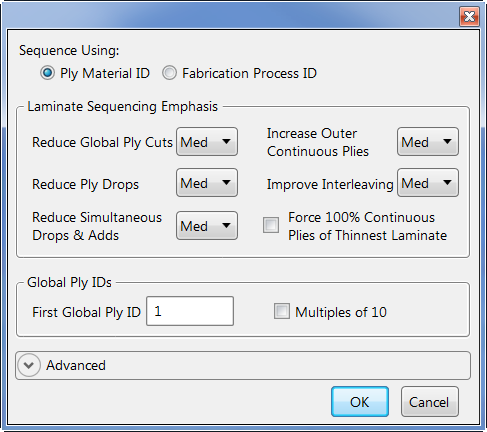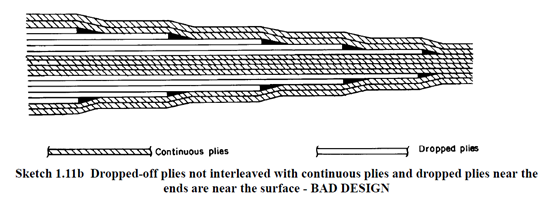
The purpose of the discrete laminate sequencing is to find both an optimal light weight and manufacturable assembly laminate. To accomplish this, multiple discrete laminate solutions are stored for each component. Then the optimal discrete laminates solutions from the Sizing form and are sequenced to find manufacturable assembly designs.

Using this step, Global plies are identified for the assembly. The global ply numbers may also be thought of as part numbers for manufacturing drawings.
The purpose of Step 5 is to assess the manufacturability of the design by converting the local plies in each laminate to global plies which are shared between the neighboring components. The designs are scored based on manufacturability metrics and the best, most desirable designs are presented to the user.
The image below displays a sequenced result across a single plydrop boundary.

HyperSizer laminate sequencing will
HyperSizer laminate sequencing will not
Annex Optimization
HyperSizer evaluates different workable solutions for each component to return a fully sequenced result for the entire assembly. Since each component in the assembly may have many workable solutions, for large assemblies, there are too many designs to evaluate. Even for this 3 by 3 plate example, where there are 9 components with 25 workable designs for each component. That's 25^9 possible designs. This sample size is too large to evaluate within a reasonable time frame.
To narrow the scope of designs HyperSizer uses an Annex optimization approach. The Annex approach starts at the component with the thinnest laminate and sequences it with the closest neighboring components. For this area the lightest 'n' number of designs are stored. These stored designs are used in the next pass where more components are annexed and sequenced into the larger area. The number of designs stored (n) and the number components that are annexed for each pass are specified in the Advanced Settings.
Scoring Algorithm
Each design is given a base score which is determined using the assembly weight and total number of global plies and ply cuts. The slider bar defines the relative weighting factor between the weight and the global plies and ply cuts. Additional penalties are added to the score based on the user-defined optimization preferences such as improving interleaving and number of simultaneous drops and adds. If a preference of N/A is selected as an optimization preference, then no penalty is added to the base score based on that particular metric. The total score is used to display the top 20 sequenced designs to the user.
Tip: How to make better sequencing results: Increase the number of requested designs on the Project Sizing form. This will provide more workable solutions per component so more compatible designs may be found, however it will make the sequencing passes run longer.

Quick Sequencing of Lightest Laminate Combination
This option displays the sequenced design for the assembly when the lightest candidates are chosen for each component. If this option is selected, no ply compatibility optimization is performed and HyperSizer will not trade different laminates to reduce the ply drops/adds. This means HyperSizer will only sequence the global plies assuming the first lightest laminate is available for each component. The intent is for this analysis to run very quickly to return the global ply sequence for the baseline, lightest laminate configuration.
Full Sequencing of All Laminate Combinations
If selected, this options will perform ply compatibility optimization for all of the components of the assembly and populate this form with the best manufacturable design that is also as light as the optimum design. If multiple designs are stored for each component, more manufacturable designs may be returned by trading laminate selections for each component.

Use the slider bar to adjusts the emphasis toward either a lighter weight or a more manufacturable assembly. The number displayed in the box records the position of the slider. Select Optimize to return a sequenced assembly solution.
Tip: The Sequencing Emphasis slider will provide many solutions that balance light weight vs. manufacturability. This step is intended to be interactive and executed many times. These solutions can be interpreted with data shown here and also with the FEM viewer.
For each sequencing preference, four choices are available: N/A, low, medium, and high. Default value = medium.

Reduce Global Ply Cuts
Set emphasis for disallowing ply cuts at the ply drop boundaries.
Reduce Ply Drops
Set emphasis for disallowing ply drops at the ply drop boundaries.
Reduce Simultaneous Drops & Adds
Set emphasis on disallowing ply drops and ply adds occurring together at a particular ply drop transition joint.
Increase Outer Continuous Plies
Set emphasis on keeping plies close to the surface continuous.
Tip: Full Assembly plies from Step 4 will enforce continuous plies on the IML/OML surfaces.
Improve Interleaving
Set emphasis on interleaving ply drops (disallowing plies to drop together at a particular ply drop transition joint). Interleaving laminate sequencing is based on ESDU 91003.
Interleaving emphasis = N/A or Low, may produce designs as illustrated below

Interleaving emphasis = Med or High, may produce designs as illustrated below.


Minimum Weight
Displays the total assembly mass if the lightest optimum laminates were used for each component in the assembly.
Select Sequence
Provides a way to see the result for each of the sequenced designs returned. You can use your mouse wheel to scroll through the list and all of the displays on the form will update. The selected design will also be displayed in the FEM Viewer.
The weight of the current Selected Design is displayed next to the sequence ID. Compare this weight to the baseline minimum weight displayed above.
Individual Drops or Adds
Displays the sum of plies either dropped or added at any transition joint in the assembly.
Simultaneous Drops & Adds
Is the total number of plies, at ply drop transitions, that have both ply drops and ply adds occurring at the same location. As an example, an assembly has two ply drop transitions. The first ply drop has 7 plies dropped, and 2 plies added. The second ply drop has 5 plies dropped and 1 ply added. The number reported here = 3. The ply-drop joints where this occurs are noted with a 'X' in the D+A column of the global plies results tab.
Global Plies
Total number of global plies in the assembly. This number should correspond to the global plies displayed in the Global Ply results tab below.
Global Ply Cuts
The total number of global ply cuts is quantified by summing the straight edge, end-of-ply boundaries for all global plies in the assembly. This metric directly corresponds to the number of actual ply cuts (fabric) or edges where the AFP tape head has to cut the fiber. This may be a more accurate way to score sequenced designs, rather than using ply drops or adds.
Maximum Plies not Interleaved
Number of plies in any angle direction that are dropping at the same time. Interleaving ply drops is considered good design practice, see Preferences, Improve Interleaving.
To provide more diverse results all sequencing preferences are evaluated at N/A and High, 32 possible combinations of settings. In some cases, this may make this analysis take longer than the Full Sequencing of all laminate combinations.
Since there are multiple ways to sequence an assembly with 1 laminate per component, the quick sequencing will return multiple designs for the assembly by varying the sequencing preferences. The sequencing preferences are..
1. Reduce Global Ply Cuts
2. Reduce Ply Drops
3. Reduce Simultaneous Drops & Adds
4. Increase Outer Continuous Plies
5. Improve Interleaving
Each can be set at N/A, Low, Med, High. In v6.4, when the quick sequencing option is turned on, HyperSizer will sequence the min wt solution for each component trying N/A and High for each sequencing preferences. 2^5 = 32 combinations.
